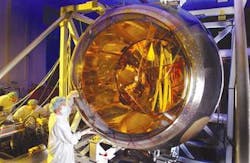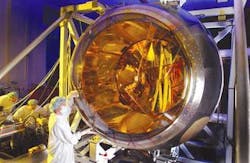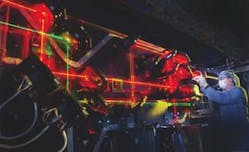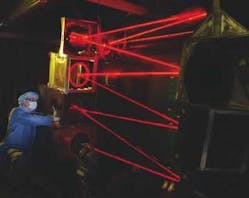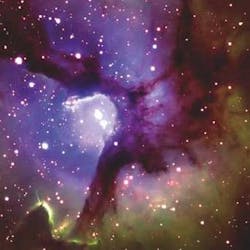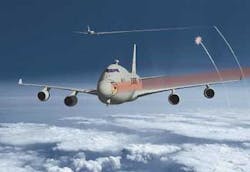This approach uses deformable mirrors, MEMS, or liquid-crystal technologies to adjust for optical distortion in the atmosphere, which yields a new level of focus and resolution to high-energy lasers, deep-space exploration, and perhaps even eye surgery.
By John Keller
Powerful optics and the Earth's atmosphere are a bad mix. The atmosphere is turbulent, ever mixing, and varies drastically in temperature; as a result it can bend and distort beams of light. The same properties that give the nighttime stars a romantic twinkle, give optical engineers fits because atmospherics can turn pinpoints of light into fuzzy blobs.
At relatively short ranges, or where precise optical resolution is not a major concern, this phenomenon matters hardly at all. Yet at long distances — particularly where precision is crucial — atmospheric distortion can be a showstopper in areas such as astronomy, covert surveillance, and long-range lasers. The problem is akin to sitting on a boat and trying to see objects lying on the bottom of a lake. Even in perfect conditions, details can disintegrate into a blurry mess.
The drive to overcome the effects of optical distortion from the atmosphere has driven scientists to some radical solutions, the most notable of which is perhaps the Hubble Space Telescope. To avoid the drawbacks of atmospheric distortion, NASA experts simply remove the telescope from the atmosphere and park it in Earth orbit. This approach is effective, yet monumentally expensive and difficult to maintain.
Another effective approach, however, offers to keep scientists well within the atmosphere — often keeping their feet firmly planted on the ground — while circumventing the forces of atmospherics. This approach is called adaptive optics, and it uses advanced sensors, actuators, and intensive digital processing to correct for atmospheric distortion just like a pair of glasses corrects for astigmatism.
The Airborne Laser
One of the most dramatic and visible applications of adaptive optics is the U.S. Air Force Boeing Airborne Laser, otherwise known as the ABL, which is designed to detect enemy ballistic missiles in boost phase and destroy them in flight with the beam from a high-energy chemical oxygen iodine laser aboard a converted 747 jumbo jet. The laser is from the Northrop Grumman Space Technology division (formerly TRW) in Redondo Beach, Calif.
Without adaptive optics, such a precise operation would be impossible because of the ranges involved. The atmosphere would blur the high-power laser beam and throw it off target, rendering it harmless to incoming ballistic missiles. Not only does adaptive optics keep the laser pointed accurately, but it also helps focus the deadly beam from 1.5 meters in diameter down to a lethal point of light.
Adaptive optics is one of the Airborne Laser's chief enabling technologies, says Dr. Robert Q. Fugate, senior scientist for atmospheric compensation, and technical director of the Starfire Optical Range at the U.S. Air Force Research Laboratory Directed Energy directorate at Kirtland Air Force Base, N.M. "You need adaptive optics to focus and concentrate a laser through atmospheric turbulence, you absolutely need adaptive optics; don't leave home without it," he says.
"The atmosphere causes the beam to spread out because of phase distortions," Fugate says. "Think of the waves of a laser beam. When the wave leaves aperture of the beam director, it is essentially flat and smooth; the rays converge as they travel." Yet that beam changes as it passes through atmospheric turbulence and temperature changes, which can slightly change the speed of the light beam. "Now I have a bumpy wavefront, and the wave becomes blurred," he says.
The Lockheed Martin Space Systems division in Sunnyvale, Calif., is responsible for laser systems aboard the ABL aircraft. "There are things in the atmosphere, or thermal effects in our optics, that distort the beam," says Paul Shattuck, technical director for the Airborne Laser project at Lockheed Martin Space Systems. "It's like astigmatism when you get blurred vision."
To counteract the influence of the atmosphere on the high-power laser, Shattuck and his team use a deformable mirror that is 1.5 meters in diameter to correct for atmospheric distortion as the beam fires. The result is a three-to-five-second burst from the high-power laser that concentrates its beam on the fuselage of a missile in flight.
The laser beam will burn a hole in the missile's skin, rupture the fuel tanks, and essentially blow the missile out of the sky. It sounds reasonably straightforward, but it is far from simple, and adaptive optics play a central role. "We use a somewhat classic approach to adaptive optics pioneered by people in the astronomical community, and adapted that to the airborne laser," Shattuck says.
Real-time processing
"Adaptive optics senses in real time; bumpy surfaces change hundreds of times per second," Fugate says. "Adaptive optics senses instant by instant what is the path that the wave will go through, and then bends a mirror to take the bumps out."
At the heart of the airborne laser's adaptive optics is the deformable mirror from Xinetics Inc. in Devens, Mass. Before the mirror does its work, however, it needs to know exactly how to compensate for the constantly changing atmospheric distortion to focus its beam and keep it on target.
To do that, the laser system uses a low-power laser literally to reach out and touch the atmosphere to determine its characteristics. "We want to determine what are the errors in our system, so we send an illuminator — another laser — all the way to the target, and we do that thousands of times a second," Shattuck explains.
The information from the illuminating laser comes into a wavefront sensor subsystem from Lockheed Martin, which maps out the atmospheric distortion. "We lay a grid on top of the beam; that's what a wavefront sensor does," Shattuck says. "Then we send that information through a bunch of software algorithms and sample the entire path that the high-energy laser will go through."
This is where the deformable mirror comes in. The deformable mirror has a very thin single-crystal silicon face sheet. On the back it has actuators about one-half inch long and about as big around as a pencil. The actuators are made from piezoelectric material, so current flowing through them makes the actuators expand or contract.
"They are all bonded to the back of the mirror in a grid pattern that is aligned with the wavefront sensor," Shattuck explains. "You take the deformable mirror and adjust it to where it is equal and opposite those distortions, so it corrects for itself.
"The best analogy is if I give my glasses to someone with perfect vision, they can't see out of them. But my glasses have equal and opposite distortion to my eyes," Shattuck says. "In the Airborne Laser, we take a beam and predistort it, and then send it through the atmosphere. If you picture optics, the beam you send out will be a flat wavefront, and all the energy is in phase. It's like 20-20 vision."
Computer-intensive
That approach sounds easy in theory, but in practice it is where much of the system's advanced electronic and optoelectronic technologies come to bear. Sampling and compensating for atmospheric distortion "is one of the most processor-intensive applications that we do," Shattuck says.
To begin, a high-speed optical-fiber interconnect moves information from the laser illuminator to a wavefront sensor for sampling. That interconnect is a Fibre Channel network called FibreXpress from Systran Corp., a Curtiss-Wright company in Dayton, Ohio.
Next, that information goes directly to high-speed digital processors, which preprocess the data and moves it through a software algorithm called a reconstructor. The reconstructor determines the "shape" of the atmosphere at any given moment, based on feedback from the laser illuminator.
For the high-speed digital processor, Lockheed Martin uses a high-speed multiprocessor from Mercury Computer Systems In Chelmsford, Mass., which uses the Race++ processor interconnect to link a series of motherboards and daughter cards. "It is a very scalable system," Shattuck says. "We just plug into more chips as we need to expand." The Mercury processor uses as many as 84 PowerPC G4 microprocessors — about 20 of which are allocated to wavefront control, Shattuck says.
After processing in the reconstructor, information then goes into a control algorithm that determines how to manipulate the actuators on the deformable mirror. Then signals flow through a series of digital-to-analog converters (D-As) and move as electric current to the various actuators. This process happens in the blink of an eye. "You know ahead of time what will happen to a flat wave as it goes through the atmosphere, and you put the opposite as it goes through a laser telescope, and it causes the beam to be focused," Fugate says.
The Airborne Laser is one of the most visible military and aerospace programs that involve adaptive optics, yet there are many more applications of this technology either in practice or on the horizon.
Astronomical applications
Perhaps the chief use of adaptive optics today is for astronomy — particularly for deep-space exploration — adaptive optics in the future, experts say, may help sharpen the focus of long-range reconnaissance sensors, improve the focus and increase the range of laser communications systems, and is even expected to enhance laser eye surgery.
"You could use adaptive optics any time you have a need to control light," Fugate says. "There might be an applicability to laser communications. Think of fiber optics, and there might be times when you might want to do free-space communications with a laser because you can get a higher data rate. Commercial companies build these devices for laser links between buildings, or across a harbor or something like that. The military will be interested in that, also, as time goes on."
One of the nation's centers of excellence in adaptive optics is the Air Force Starfire Optical Range in New Mexico, which Fugate oversees and uses to develop optical wavefront-control technologies. This range has a 3.5-meter telescope, which is one of the largest telescopes in the world equipped with adaptive optics designed for satellite tracking. The range also has a 1.5-meter telescope and 1-meter beam director.
The Starfire Optical Range's adaptive-optics mirror is more than twice the size of the deformable mirror aboard the Airborne Laser, and its computing power is far more complex.
"On our 3.5-meter telescope at Kirtland, we have about 800 lenselets that we use to sample the direction that the light is traveling," Fugate says. "Then we put those 800 spots of light on a 2-D focal-plane array. We want these spots to be in a perfectly organized grid."
When any of the 800 points of light fall out of perfect alignment, an error signal tells the deformable mirror's actuators to move the straying points of light back on axis. "We are trying to straighten out the wavefront," Fugate says. "The actuators bend the surface of the mirror to give it bumps, valleys, and dips to match those in the wavefront."
Fugate explains that while the computational power of the Starfire Optical Range is intense, it is not a limiting factor. "You have to do everything in parallel," he says. "At our system here we have 1,000 processors running in parallel, programmed to do one job, and that is matrix multiplication."
Gigabytes per second
"We send gigabytes of data through this processor per second," Fugate continues. "We have to read pixels out of a camera, do computations to generate directions for these lenselets, and reconstruct with matrix multiplications or some other algorithm. We update the mirror thousands of times per second."
Not only is the Starfire Optical Range an optical laboratory, but it has turned into a computing laboratory, as well. "We designed and built the processors here." Historically, Fugate and his team have used dedicated digital signal processors (DSPs) for adaptive-optics processing, but lately are experimenting with field-programmable gate arrays (FPGAs) to get the most from the system.
The range's adaptive-optics computing uses 16-bit fixed-point processing, and a 40-bit accumulator. "It is rather memory intensive," Fugate says. Converting signals from analog to digital, and back into analog very quickly is an extremely important part of the process to update the mirror thousands of times each second.
The range's 3.5-meter mirror has 941 actuators — about three times the number on the Airborne Laser, and each actuator can move up and down about an inch. The system's 16-bit digitizers help these actuators give the mirror very fine control, he says.
Looking forward, deformable mirrors are not the only way to keep light focused through the turbulent atmosphere. These mirrors are expensive, can be difficult to maintain, and take a lot of space. As alternatives, scientists are investigating technologies such as microelectromechanical systems (MEMS) and transmissive liquid-crystal devices to help bring down costs and shrink the size of adaptive optics.
New optical technologies
"There is a lot of new technology coming along that involves different devices for wavefront correctors," Fugate says. Many applications for the kinds of adaptive-optics systems that these technologies will yield are also on tap for the future.
MEMS technology potentially will yield small mirrors made of many microscopic independently adjustable mirrors that could function digitally in much the same way as the Airborne Laser's deformable mirror, Fugate says. "MEMS will bring lower cost and more availability because they are cheaper to make, and have broad applicability to other applications," he says.
Transmissive liquid-crystal arrays also have promise. "If you make a liquid crystal so it has pixilated areas, and apply an electric field to change the optical path length of that crystal, you can put a small bump in the wavefront," Fugate says.
One area where relatively small and inexpensive adaptive optics systems could be most useful is laser eye surgery. "Adaptive optics is starting to sneak into human vision," Fugate says. "Lasik is eye surgery with a laser to improve your vision. Up to now it has used a simple formula to do that, but with adaptive optics people are now capable of measuring the higher-order distortions in your eye lens."
Experts could use the fine measurement of distortions in an eye lens "as a recipe to alter the shape of the lens in your eye," Fugate says. "It would give people better-quality vision."
Research opportunities
At least one pressing need for adaptive-optics research currently involves long-range infrared cameras operating in the 1- to 2-micron light wavelength. "Lots of cameras operate in the visible light spectrum, but if we need to do infrared tracking, we need to do work in that spectrum," Fugate says. "There is not much of a commercial market here."
When it comes to adaptive optics for infrared, "performance is important; we have to have low noise and a high frame rate in the thousands of frames per second range," Fugate says. Noise levels should be no greater than 10 electronics of read noise per pixel, and greater than 80 percent quantum efficiency — or the fraction of photons converted to electronics, he says.
Perhaps more beneficial to scientists even than the Airborne Laser is what adaptive optics offers to advanced astronomy. "Adaptive optics is revolutionizing ground-based optical astronomy," Fugate says. "There are 15 or so 8-meter telescopes in the world now, and there are plans to build 30-meter telescopes and even a 100-meter telescope. It makes no sense to do that without adaptive optics because the atmosphere limits the size of your telescope to about 8 inches."
Some scientists have speculated that advanced adaptive optics in the future could render obsolete the space-based telescopes such as the Hubble, which has a 2.4-meter telescope. "The Hubble Space Telescope is successful because there is no atmosphere, and that allows you to obtain a perfect image," Fugate says.
Without atmosphere, the diameter of the telescope determines its resolution. "If I had a telescope in space, the larger I make that telescope the more resolution and finer detail I can see," Fugate says.
Realistic expectations
Despite the advantages of adaptive optics, placing telescopes in space brings more to science than focus and resolution.
"Adaptive optics will not render the Hubble obsolete," Fugate says. "The next James Webb telescope will look at wavelengths that don't get through the atmosphere. It will be far from the Earth, in orbit around the Sun, where it is very cold. Scientists could look at the very faint infrared type objects in the universe because the thermal background will be incredibly low, and that's not something we can do on Earth."
The James Webb Space Telescope (JWST), which is set to launch in August 2011, is to be an orbiting infrared observatory that will take the place of the Hubble Space Telescope to study the universe at the previously unobserved epoch of galaxy formation. It will be able to see through dust to witness the birth of stars and planetary systems.
Still, Fugate says some of today's space images taken from adaptive-optics telescopes on Earth "are better than what Hubble can do, in visible light; they can eliminate the limits of the atmosphere."
Might some of the new technologies on the horizon for adaptive optics render the large and expensive deformable mirrors obsolete? That might be a possibility for some applications, but not likely for weapons-grade laser control and for astronomy, Shattuck says.
"I believe the deformable mirrors we have will be around for a long time because you can get a bigger stroke, and change the shape by a larger amount," Shattuck says. "The deformable mirror moves more than what MEMS does. MEMS are etched silicon and can only move in fractions of a micron. Our wavelengths are 1.315 microns, so ideally I want to correct for errors that might be multiple wavelengths, and want multiple microns of change." He suggests, however, that MEMS may offer laser and astronomical applications some degree of fine control.
As for liquid-crystal adaptive optics, Shattuck says laser control and astronomy might not be its best use. "With liquid crystal, you send the beam through it, and by changing the characteristics of the liquid, you change the index of refraction, or the way light is reflected, and can correct the wavefront. That works quite well for smaller beams, and with beams with less power, but I don't believe they will get to where you could use them with a high-energy laser."
